Dumbbell forearm exercises are an excellent way to improve your grip and wrist strength. They’re easy to use and versatile enough to target various forearm muscles at home or the gym.
Forearm exercises with dumbbells allow unilateral training (working each forearm independently), which helps address any muscle imbalances between your dominant and non-dominant arms.
Dumbbells provide significant movement flexibility, enabling one to train forearm muscle groups from diverse angles and with a good range of motion.
Below are some top forearm exercises you can do with dumbbells at home or in the gym to build forearm size and strength.

- Dumbbell Forearm Exercises
- 1. Seated Dumbbell Wrist Curls
- 2. Dumbbell Reverse Wrist Curl
- 3. Seated Neutral Dumbbell Wrist Curl
- 5. Seated Finger Curl
- 6. Dumbbell Wrist Twist
- 7. Dumbbell Reverse Curl
- 8. Behind-the-back dumbbell Finger Curls
- 9. Dumbbell Farmer’s Walk
- 10. Hammer Curl
- 11. Zottman Curl
- 12. Dumbbell Reverse Grip Concentration Curl
- Forearm Dumbbell Workout Samples Routine
- 1. Sets For Forearm
- 2. Repetitions (Reps) For Forearm
- 3. Frequency
- 4. Beginner Forearm Workout Plan
- 4. Intermediate Workout Plan
- Forearm Muscles
- Flexor Muscles
- Extensor Muscles
- Pronator and Supinator Muscles
- Brachioradialis
- Conclusion
- References:
Dumbbell Forearm Exercises
Exercises that work multiple forearm muscles simultaneously can improve grip strength and forearm without spending too much time on forearm training.
1. Seated Dumbbell Wrist Curls
Seated dumbbell wrist curls are isolation exercises primarily targeting the muscles responsible for wrist flexion, specifically the wrist flexor group.
By strengthening your wrist flexors, you can reduce the risk of wrist injuries, such as strains or sprains, especially when you do repetitive wrist movements or heavy gripping.
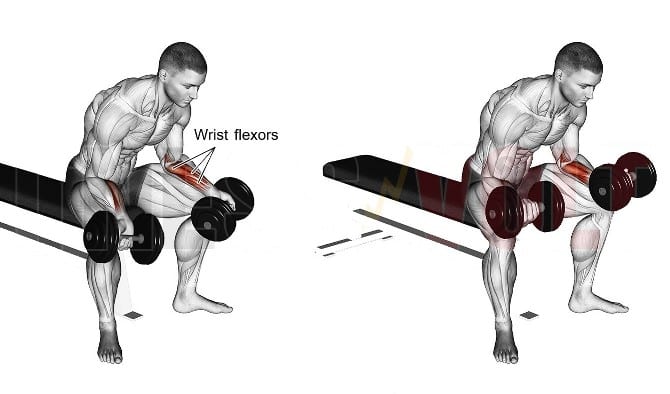
How To Do Palms-Up Wrist Curl
- Sit on a bench or chair with your feet flat on the floor and your knees at a 90-degree angle.
- Hold a dumbbell in each hand with an overhand grip (palms facing down) and rest your forearms on your thighs.
- Slowly bend your wrists to lower the weight towards your fingers, keeping your upper arms stationary.
- Hold a moment at the bottom of the movement, then slowly extend your wrists to raise the weight back to the starting position.
- Repeat 10–15 reps per set.
2. Dumbbell Reverse Wrist Curl
Reverse wrist curls are similar to regular wrist curls, but with a reversed hand position that primarily targets the extensor muscles (back of the forearm). In addition to the wrist extensors, the reverse wrist curl also engages the brachioradialis and other forearm muscles.
Strong extensor muscles contribute to better grip stability and control. This can benefit activities requiring a firm grip, such as weightlifting, racket sports, and manual labor.
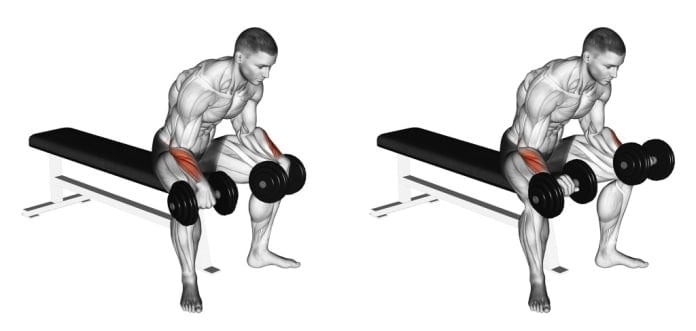
How To Do Palms-Down Wrist Curl
- Sit on a flat bench with your legs bent and your feet flat on the floor.
- Place your forearms on your thighs, with your wrists hanging off the edge.
- Hold a barbell or a pair of dumbbells with your palms facing down.
- Lower your wrists down as far as comfortably possible, bending your wrist joint.
- Curl your wrists back up by raising the dumbbells towards your forearms, squeezing the extensor muscles at the top of the movement.
- Hold the contraction for a second, then slowly lower the dumbbells to the starting position.
3. Seated Neutral Dumbbell Wrist Curl
The seated neutral dumbbell wrist curl specifically targets the flexor muscles of the forearms. Hold a dumbbell with a neutral grip (palms facing each other) to perform wrist curls.
It helps you enhance hand-grip endurance, which is particularly advantageous for activities that require consistent hand-grip power over a prolonged period, such as climbing rocks or playing tennis.
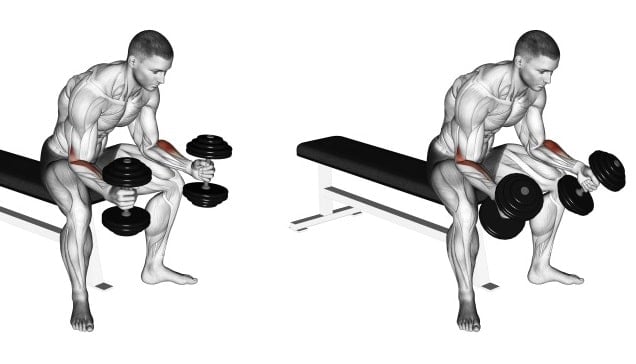
How To Do Neutral Dumbbell Wrist Curl
- Sit on a bench or chair with your feet planted on the ground and your back straight.
- Hold a dumbbell in each hand with a neutral grip (palms facing each other).
- Rest your forearms on your thighs, allowing your wrists to hang off the edge.
- Slowly curl your wrists upward by flexing the forearms while keeping your forearms stationary.
- Hold the peak contraction momentarily, then slowly lower the dumbbells back to the starting position.
5. Seated Finger Curl
The seated finger curls specifically target the muscles responsible for finger flexion. Dumbbell finger roll is particularly effective for strengthening the fingers and grip strength.
A solid grip and strong fingers are beneficial for activities that require grasping, holding, or manipulating objects, such as weightlifting, rock climbing, and everyday tasks.
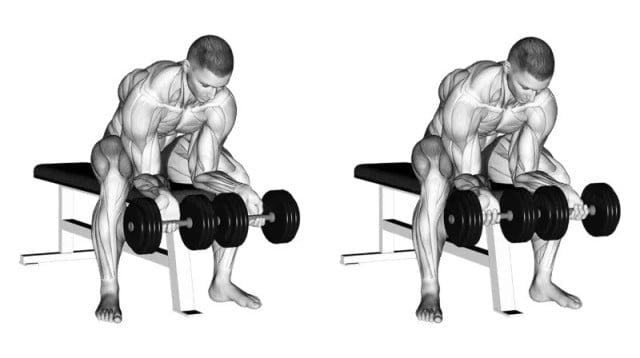
How To Do Dumbbell Finger Rolls
- Sit on a bench or chair with your feet flat on the ground.
- Hold the dumbbell in one hand with your palm facing upwards, and let it rest on your fingers, not your palm.
- Using only your fingers, curl them towards your palm, causing the dumbbell to roll upwards. Keep the motion controlled and smooth.
- When the weight reaches your fingertips, reverse the movement by extending your fingers and letting the weight back up.
- Do 8-12 controlled repetitions for each hand.
- Once you’ve completed the desired reps on the one hand, switch to the other and repeat the process.
6. Dumbbell Wrist Twist
The dumbbell wrist twist, also known as pronation and supination, is an exercise that focuses on strengthening the muscles responsible for rotating the forearm, specifically the pronator’s and supinators’ forearm muscles.
To perform it, you hold the dumbbell and rotate the wrist to perform pronation (inward rotation) and supination (outward rotation) movements.
This exercise simulates the rotational movements required for daily activities and sports, such as turning a doorknob, swinging a golf club, or throwing a ball.
How To Do Dumbbell Wrist Twist
- Stand or sit properly and hold a dumbbell in one hand with an underhand grip (palms facing up).
- Rest your forearm on a bench or thigh, keeping your wrist just beyond the edge and allowing it to move freely.
- Start by hanging the dumbbell parallel to the floor and your palm facing inward (pronation).
- Slowly rotate your wrist outward, moving the dumbbell upward until your palm faces upward (supination).
- Pause briefly at the top of the movement and then rotate your wrist back inward to return to the starting position.
- Do 10-15 reps, then switch to the other hand.
7. Dumbbell Reverse Curl
The Dumbbell Reverse curl is a variation of the standard bicep curl, where the barbell is gripped palms up. It targets your brachioradialis, brachialis and many other muscles in your forearms.
The motion is the same, but the change in grip allows specific arm muscles to be targeted.

How To Do Dumbbell Reverse Curl
- Stand straight, keeping your feet shoulder-width apart.
- Grab a dumbbell in each hand using an overhand grip, and arms should be fully extended.
- Curl the dumbbell up towards your shoulders and exhale as you do so.
- Continue curling the dumbbells until they are at shoulder level and your biceps are fully contracted.
- Return to the starting position in a smooth arc, and inhale as you do so.
8. Behind-the-back dumbbell Finger Curls
Behind-the-back dumbbell finger curls are a variation of finger curls that primarily focus on strengthening the muscles of the fingers and forearms.
It increases the range of motion and puts more emphasis on finger flexion.

How To Do It
- Stand with your feet shoulder-width apart and hold a dumbbell in each hand.
- Rotate your arms externally, bringing the dumbbells behind your back, with your palms facing backward.
- Let your arms naturally hang down with the dumbbells behind your hips.
- Keeping your arms still, curl your fingers and squeeze, flexing your fingers as much as you can.
- Hold the contracted position for a moment, then slowly release and extend your fingers to return to the starting position.
9. Dumbbell Farmer’s Walk
The Farmer’s walk is a functional exercise that can build grip and forearm strength. It involves holding a pair of heavy dumbbells at your sides and walking with them for a set distance or time.
It is relatively simple to perform but challenging as the weight used for this exercise is usually quite heavy.
This exercise can be quite challenging. You should start with a moderate weight and increase it gradually as you build your strength.

How To Do
- Start by selecting a pair of heavy dumbbells that are challenging but still manageable.
- Stand with your feet hip-width apart and your knees slightly bent.
- Take a dumbbell in each hand and let them hang at your sides.
- Keep your back straight and your core engaged throughout the exercise.
- Begin walking forward, keeping a steady pace and maintaining good form.
- Walk for the desired distance or time, then briefly release the weight and rest before repeating.
10. Hammer Curl
The Hammer Curl is a classic weightlifting exercise that targets the biceps and brachialis.
Regarding building muscular hypertrophy and strength, the hammer curl exercise is one of the most popular brachialis exercises among bodybuilders and regular weightlifters.

How To Do
- Stand with your feet shoulder-width apart and a slight bend in your knees.
- Hold dumbbells in your hands with your palms facing towards your body.
- Keeping your elbows close to your body, slowly curl the dumbbell up to your shoulders.
- At the top of the lift, pause for a second, squeeze your brachialis and lower the weights under control.
Tips
- Raise and lower the dumbbell slowly. Use your strength, not momentum or gravity, to keep in control.
- Neither leans back as you lift the weight nor forward as you lower it.
11. Zottman Curl
The zottman curl is one of the best variations of the standard bicep curl. The Zottman curl utilizes different hand positioning at different portions of the lift.
The first portion, the regular curl, focuses on forearm and bicep strength.
You can perform Zottman curls with both arms simultaneously, or alternate the arm you lift with.

How To Do
- Hold a pair of dumbbells to your sides.
- Keep your palms facing up as you curl the weights up to your shoulders.
- Pause at the top of the movement.
- Slowly rotate your grip so your palms are facing downwards.
- Lower the dumbbells slowly back to the starting position using an overhand grip.
- When the dumbbells are close to your thighs, again turn your hands while returning to the starting position.
12. Dumbbell Reverse Grip Concentration Curl
The Reverse grip dumbbell concentration curl is a great basic move. When done correctly, it can effectively target your forearms and the biceps brachii and brachialis muscles.

How To Do
- Sit on a bench with your legs apart, and grab a dumbbell in one hand (say left hand).
- With your left arm almost fully extended, rest your elbow against the inside of your left thigh.
- Pronate your wrist so that your palm faces backward.
- Exhale as you curl the dumbbell up towards your shoulder.
- Hold and squeeze your biceps for a count of two.
- Inhale as you slowly lower the dumbbell to the starting position.
- Repeat with your right arm.
Tips
- Don’t lock out at the bottom of the exercise.
- Keep your back straight and your upper arm still.
Forearm Dumbbell Workout Samples Routine
Forearm exercises should be performed at a frequency that is appropriate for each individual’s fitness level, goals, and recovery ability.
Nevertheless, there are some general guidelines to help you get started.
1. Sets For Forearm
- Beginners: Start with 2–3 sets per exercise.
- Intermediate: Aim for 3–4 sets per exercise.
- Advanced: Perform 4–5 sets per exercise.
2. Repetitions (Reps) For Forearm
- Strength and Power: Focus on lower reps (around 6-8) with heavier weights to challenge the muscles and promote strength gains.
- Hypertrophy (Muscle Growth): Aim for moderate reps (around 8-12) with weights that fatigue the muscles within the desired rep range.
- Endurance: Perform higher reps (around 12-15 or more) with lighter weights to build muscular endurance.
3. Frequency
- Beginners: Start with 1-2 forearm workouts per week, allowing ample recovery time between sessions.
- Intermediate: Aim for 2-3 forearm workouts per week, with at least two days of rest in between.
- Advanced: Perform 3-4 forearm workouts per week, incorporating various exercises and intensity levels.
4. Beginner Forearm Workout Plan
| Exercise | Reps | Sets |
|---|---|---|
| Dumbbell Wrist Curls | 10-12 | 3 |
| Reverse Dumbbell Wrist Curls | 10-12 | 3 |
| Farmer’s Walk (with Dumbbells) | 30 seconds | 3 |
4. Intermediate Workout Plan
| Exercise | Reps | Sets |
|---|---|---|
| Dumbbell Wrist Curls | 8-10 | 4 |
| Reverse Dumbbell Wrist Curls | 8-10 | 4 |
| Behind-the-Back Wrist Curls | 10-12 | 3 |
Forearm Muscles
The forearm is a complex area of the upper limb that contains numerous muscles responsible for various movements and functions.
To effectively target the forearm muscles with dumbbell exercises, it is essential to understand them.
Let’s delve into the key muscles of the forearm:
Flexor Muscles
- Flexor Digitorum Profundus: This muscle runs along the forearm and flexes the fingers.
- Flexor Digitorum Superficialis: Positioned above the flexor digitorum profundus, this muscle also flexes the fingers.
- Flexor Carpi Radialis: Located on the inner side of the forearm, this muscle flexes and abducts the wrist.
- Palmaris Longus: this muscle aids wrist flexion and tenses the palmar aponeurosis.
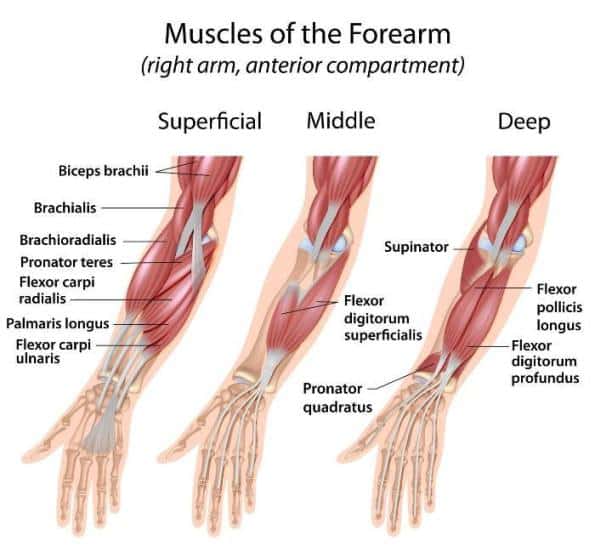
Extensor Muscles
- Extensor Digitorum: Positioned on the back of the forearm, this muscle extends the fingers.
- Extensor Carpi Ulnaris: Located on the outer side of the forearm, this muscle extends and adducts the wrist.
- Extensor Carpi Radialis Longus and Brevis: These muscles extend and abduct the wrist.
Pronator and Supinator Muscles
- Pronator Teres: Positioned on the inner side of the forearm, this muscle pronates the forearm (rotates it to face downward).
- Pronator Quadratus: Located near the wrist, this muscle assists in pronation.
- Supinator: Situated on the outer side of the forearm, this muscle supinates the forearm (rotates it to face upward).
Brachioradialis
This muscle runs along the outer side of the forearm and aids in flexion and rotation.
Conclusion
Dumbbell forearm exercises are an excellent way to improve grip strength and wrist stability. Dumbbells are versatile and effective training tools that provide movement variability and the ability to perform unilateral exercises.
With just a pair of dumbbells, you can achieve impressive results. Focus on the wrist flexor, extensor, pronator, and supinator muscles for improved performance.
It is essential to challenge yourself constantly to ensure continued progress. As you get better at the exercises, try increasing the weights, adding new exercises, or changing the intensity or volume of your workouts.
References:
- Mathiowetz, V., et al. (2004). Grip and Pinch Strength: Norms for 6- to 19-Year-Olds. The American Journal of Occupational Therapy, 58(2), 97-104.
- Stasinopoulos, D., & Johnson, M. I. (2007). Cyriax Physiotherapy for Tennis Elbow/lateral Epicondylitis. British Journal of Sports Medicine, 41(11), 639-642.
- Hindle, B.R., Lorimer, A., Winwood, P. and Keogh, J.W.L. (2019). The Biomechanics and Applications of Strongman Exercises: a Systematic Review. Sports Medicine – Open, 5(1). doi:https://doi.org/10.1186/s40798-019-0222-z.
- Forman, D.A., Forman, G.N., Avila-Mireles, E.J., Mugnosso, M., Zenzeri, J., Murphy, B. and Holmes, M.W.R. (2020). Characterizing forearm muscle activity in young adults during dynamic wrist flexion–extension movement using a wrist robot. Journal of Biomechanics, 108, p.109908. doi:https://doi.org/10.1016/j.jbiomech.2020.109908.

Manish brings over 10 years of hands-on experience in weight lifting and fat loss to fitness coaching. He specializes in gym-based training and has a lot of knowledge about exercise, lifting technique, biomechanics, and more.
Through “Fit Life Regime,” he generously shares the insights he’s gained over a decade in the field. His goal is to equip others with the knowledge to start their own fitness journey.
